- Resources
How to Create a Customer Journey Map
Touchpoints aren’t enough to produce a 1.7x revenue growth that a customer journey map promises. You need the right components for it to work.
A customer journey (CJ) map is a visual representation of the customer’s end‐to‐end interaction with the business. Here, end‐to‐end means from the moment they hear about your business to the moment they become a customer and later become brand advocates.
While the definition of a customer journey may seem simple and short, the maps are contrastingly complex and varied.
There are different types of customer journey maps and they can take the form of a graph, infographic, or Excel spreadsheet.
Creating a customer journey map is not a straightforward task, but sticking to the basics will certainly help the process. There are nine steps to creating a customer journey map. These are:
- Define Your Objective
- Create a Customer Persona
- Break Down the Journey into Key Stages
- Define Customer Goals
- List the Touchpoints
- Identify Customer Actions
- Note the Customer’s Emotions
- Identify Pain Points and Roadblocks
- Propose Solutions
We follow these exact steps to create an effective customer journey map in the following sections. You can then use the map to offer a great customer experience.
What does a Customer Journey Map Contain?
While the customer journey maps are varied, they contain more or less the same information. In other words, they have the same components, which are just conveyed differently.
Most comprehensive customer journey maps contain the following information:
- Buying Process – The buying process is the path you anticipate the customer will take to purchase your product. All users go through five distinct phases: awareness, consideration, purchase, retention, and loyalty.
- Mindset – Mindset corresponds to the questions, thoughts, and motivations running through the customers’ minds at each stage of the journey.
- Touchpoints – Touchpoints are any type of interaction a customer can have with your business. This can be a phone call, store visit, product return, etc. Touchpoints are perhaps the most important component of a customer journey map since that’s where the users take action.
- Emotions – Whenever a customer gets in touch with your business, they’re likely to experience some sort of emotions. It could be happy, sad, or neutral. A customer journey map should cover emotions possibly at each touchpoint.
- Solutions – These are the proposed initiatives you plan to take to improve the overall customer experience. You should create solutions for every phase of the customer journey and for every touchpoint where the emotions are negative.
There are other components a customer journey map could contain like buyer persona, pain points, opportunities, MoTs (Moments of Truths), internal ownership, and KPIs. How many components to include would depend on the purpose, scope of the project, and data availability.
Download our free customer journey template.
Create and analyze your own customer journey

Types of Customer Journey Maps
As already mentioned, there are different types of customer journey maps. Some are more complex than others, hence requiring more time and resources to create. But you have the flexibility to pick and choose depending on your goals.
The four most common types of customer journey maps are:
Current State
The current state customer journey map details the experience of the users at the present stage. This includes what their perception of the brand is right now and the interactions they’ve had recently.
Current state maps are best suited for understanding customer behaviour and improving the user experience. The data primarily comes from observational research and analytics tools like Google Analytics.
Future State
The future state journey map is intended to conceptualise and visualise the journey of the users at a later stage. These map types are mostly used after analysing current state CJ maps to further optimise performance.
Based on the analysis, you’ll have better anticipation of user actions and behaviours. Future state maps can serve as the north star for teams working on future projects and improving the existing features.
Day in a Life
Day in a life customer journey map aims to map the day-to-day activities of a particular user. This includes interactions they have with your competitors and related services. Day in a life CJ map gives you a wider view of the lives of your customers and helps identify pain points and opportunities. Teams use this map type when they want to learn more about their target customers beyond their interaction with the brand.
Service Blueprint
Service blueprints are secondary maps developed in conjunction with a customer journey map. It details the frontstage and backstage processes and services in place to fulfil the customer’s needs at each stage.
This can include staff, protocols, policies, software, hardware, feedback forms, etc. A service blueprint helps ensure the organisation is responding to the customer journey and delivering value at each touchpoint.
How to Create a Customer Journey Map (Step‐by‐step)
Now that you know the components of a customer journey map and the various types, it’s time to build one from scratch. As an example, we’ll take the case of a job board company that is mapping the journey of its customer persona.
You can use diagram software or a simple Excel spreadsheet, depending on the resources you have. For this article, we’ll be using Google Docs for demonstration purposes.
With that said, here are the steps you need to take to create a customer journey map:
Define Your Objective
Before anything else, you need to have clarity on why you’re creating the customer journey map in the first place. Without this, you’ll struggle to focus on the areas or the stages that matter.
Are you looking to drive more sales? Generate more leads? Scale your business? Launch a new feature? The goals you set will dictate the type of CJ map to create and how to process the information.
Therefore, the very first thing you need to do is define your objective at the very top. If you’re still not clear on it, sit down and spend some time clarifying your goal by seeking feedback from team members.
Create Customer Persona
The next step is to create a customer persona. This is the ideal customer you’re serving or planning to serve in the near future. You must define him/her first, based on the market research and customer data you’ve gathered.
Please note that you can have more than one buyer persona. If you’re targeting males and females separately, then the customer persona will change. Likewise, if you define them by age, you’ll have multiple customer personas. It’s recommended that you create separate customer journey maps for different personas.
So, write down the customer persona in the following column like this:
Break Down the Journey into Key Stages
Customer journey maps can be longer if you have more touchpoints and/or sell an expensive product. To make it digestible, you should break down the journey into key stages.
There are four stages in most CJ maps: awareness, consideration, purchase, and retention. But you should affix loyalty to the list if you’re concerned about customer loyalty. You can also divide the stages for more clarity. For example, you can sub-categorise the consideration phase into information and comparison.
Likewise, you can divide the purchase stage into free trial and paid. But a few companies have their free trial offer in the consideration phase. Thus, you should break down the journey as per the planning.
Here’s how the CJ map that we’re creating should look like:
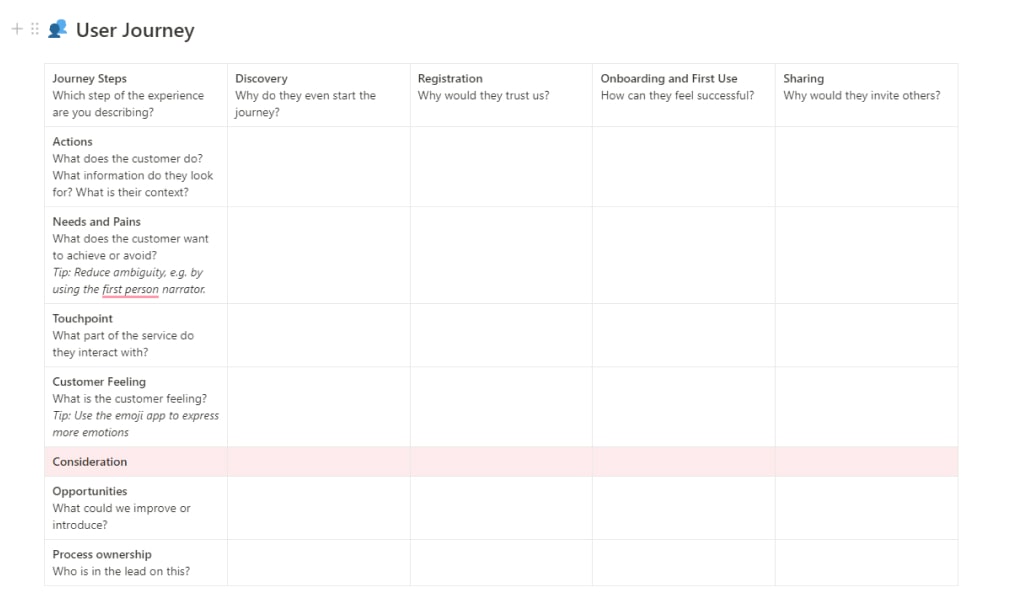
Define Customer Goals
Now turn the focus onto the customer. It’s time to get inside their mind and figure out the questions they have at each stage. For this, it’s best to hold focus groups with existing and past users and collect feedback continuously. The more conversations you have, the better clarity you’ll have.
In case you do not have the exact information, make your best guess for the questions your customers might have at each stage. Then validate it down the road.
After this step, here’s how our CJ map will resemble:

Define Customer Goals
Now turn the focus onto the customer. It’s time to get inside their mind and figure out the questions they have at each stage. For this, it’s best to hold focus groups with existing and past users and collect feedback continuously. The more conversations you have, the better clarity you’ll have.
In case you do not have the exact information, make your best guess for the questions your customers might have at each stage. Then validate it down the road.
After this step, here’s how our CJ map will resemble:
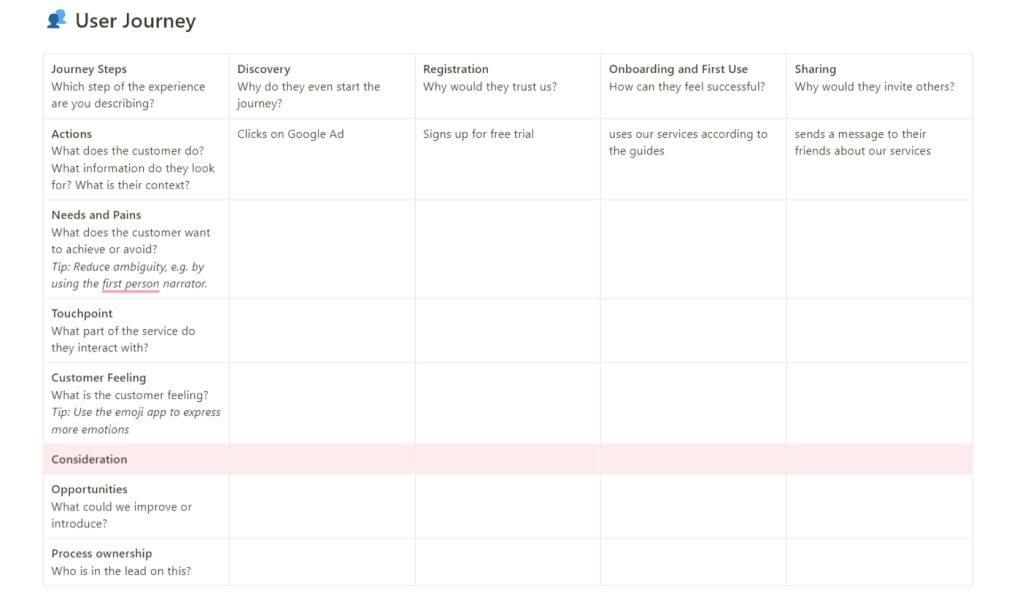
Identify Needs and Pain Points
If you’re trying to solve problems, your customer journey map must include pain points. That’s how you can identify where users are having trouble completing the tasks to move on to the next stage. However, if you just want to map the journey, you can skip this part.
For this example, we want to understand where leads are dropping off. Thus, after collecting customer feedback data and correlating it with analytics data, we arrived at the following conclusion:

List the Touchpoints
The next component to map on the customer journey map is the touchpoint. These are all the interactions a customer can have with the brand in both digital and physical channels. Usually, you’ll have more than one touchpoint at each stage. And customers can use any touchpoint that’s more convenient for them.
To figure out the exact touchpoint customers (or a customer segment) are using, dive into the analytics data. Then combine it with the feedback data since analytics data can’t possibly account for offline interactions.
After listing the touchpoint, the map should look like the following:
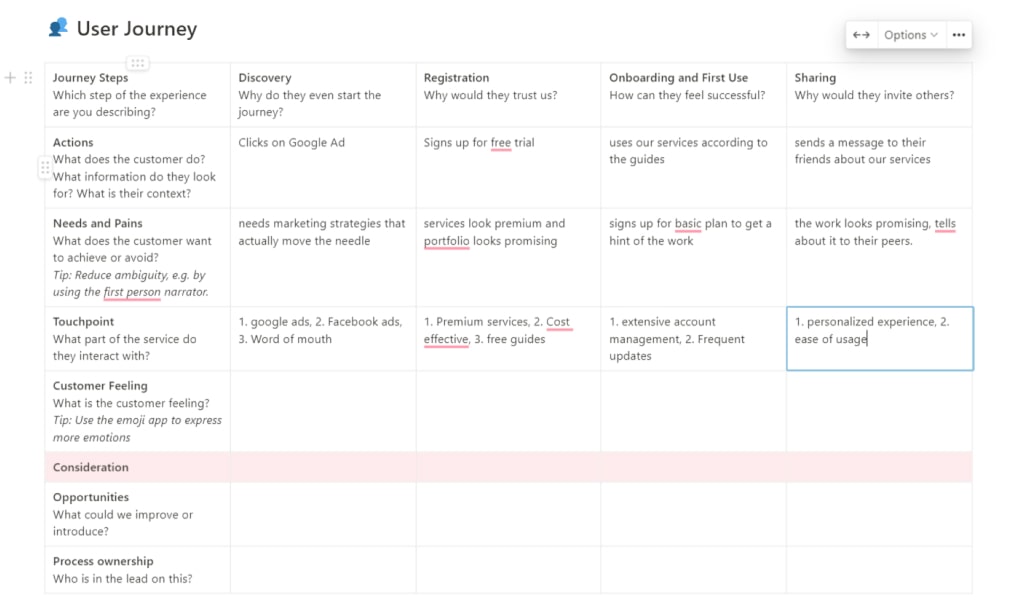
Note the Customer’s Emotions
Your customers will go through a range of emotions throughout the journey. A customer journey map must include the emotions for each stage or each touchpoint. This will help you relate to users’ emotional states and understand their actions.
In most cases, the data comes from customer feedback or direct customer interaction. Once you have gathered the data, input it into the CJ map. For this example, we’ve used emojis to map the emotions.
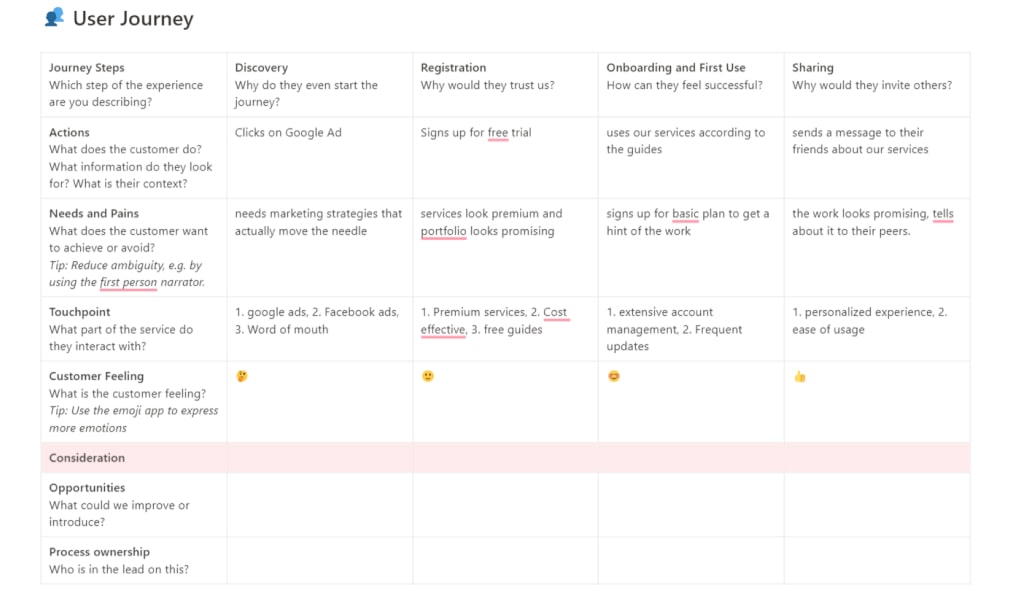
Propose Solutions
The last component you’d want to include in your customer journey map is solutions for improvement. These should address the pain points you have identified in the previous step.
For this example, we have addressed the customer’s two pain points in the consideration and purchase phases. So the customer journey map looked like this:
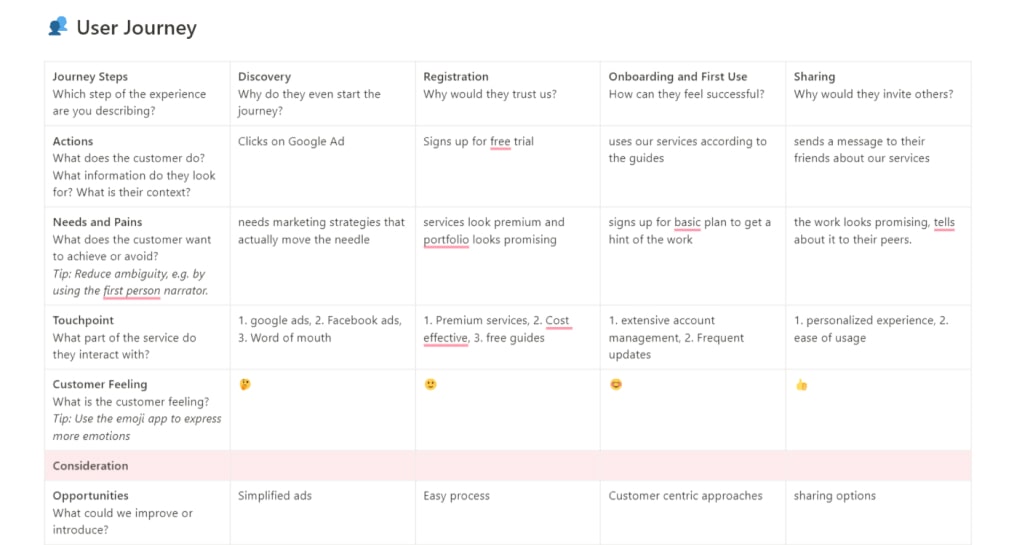
This map now gives a complete picture of the customer journey. It answers questions like how the customer learns about the company, what triggered him to subscribe and upgrade, and where he exited the journey.
Concerning the objective, this customer segment didn’t drop off and went all the way to the sharing stage. So this is the perfect customer segment. You’d have to repeat the process for other customer segments to figure out if and where they’re dropping off.
The template that you see here is handcrafted by us to suit your convenience and you can use it for free to create and analyze your own customer journey.
In conclusion, that’s how you create a customer journey using our free customer journey template from. You can always make modifications to suit your project needs. But the overall essence should be the same.
Download our free customer journey template.
Create and analyze your own customer journey
